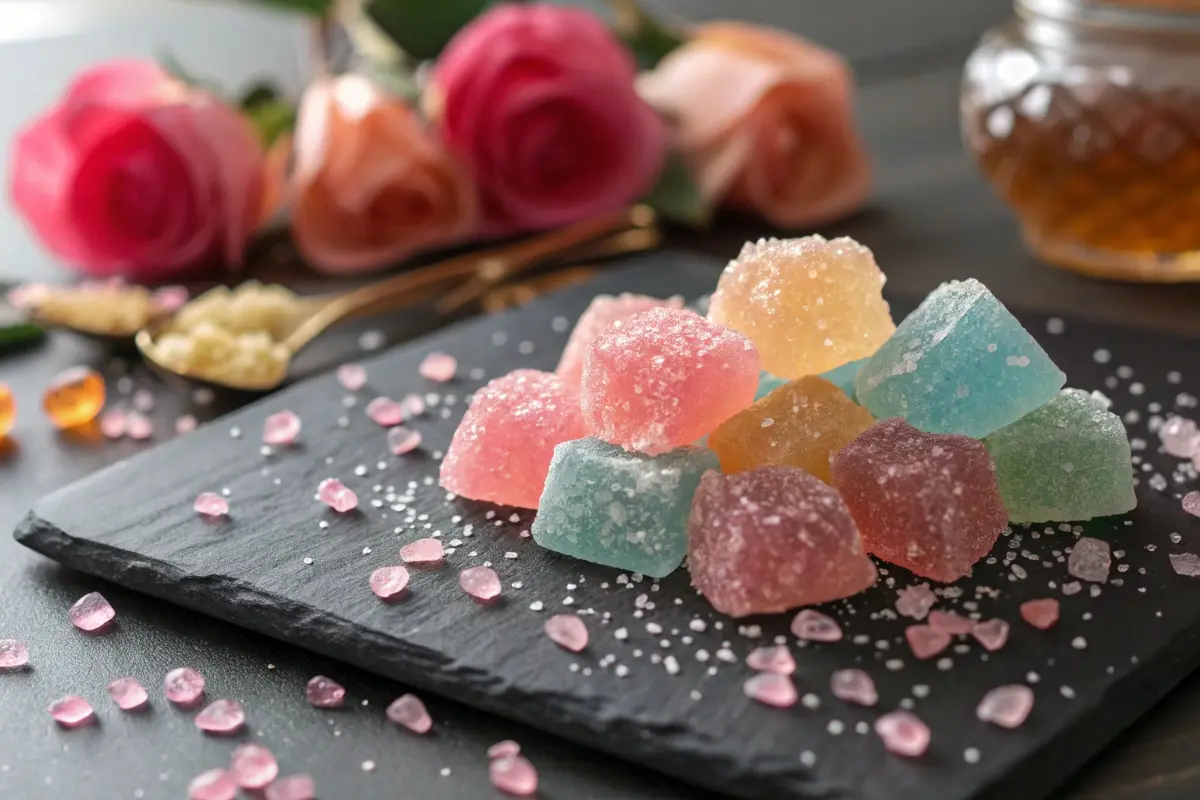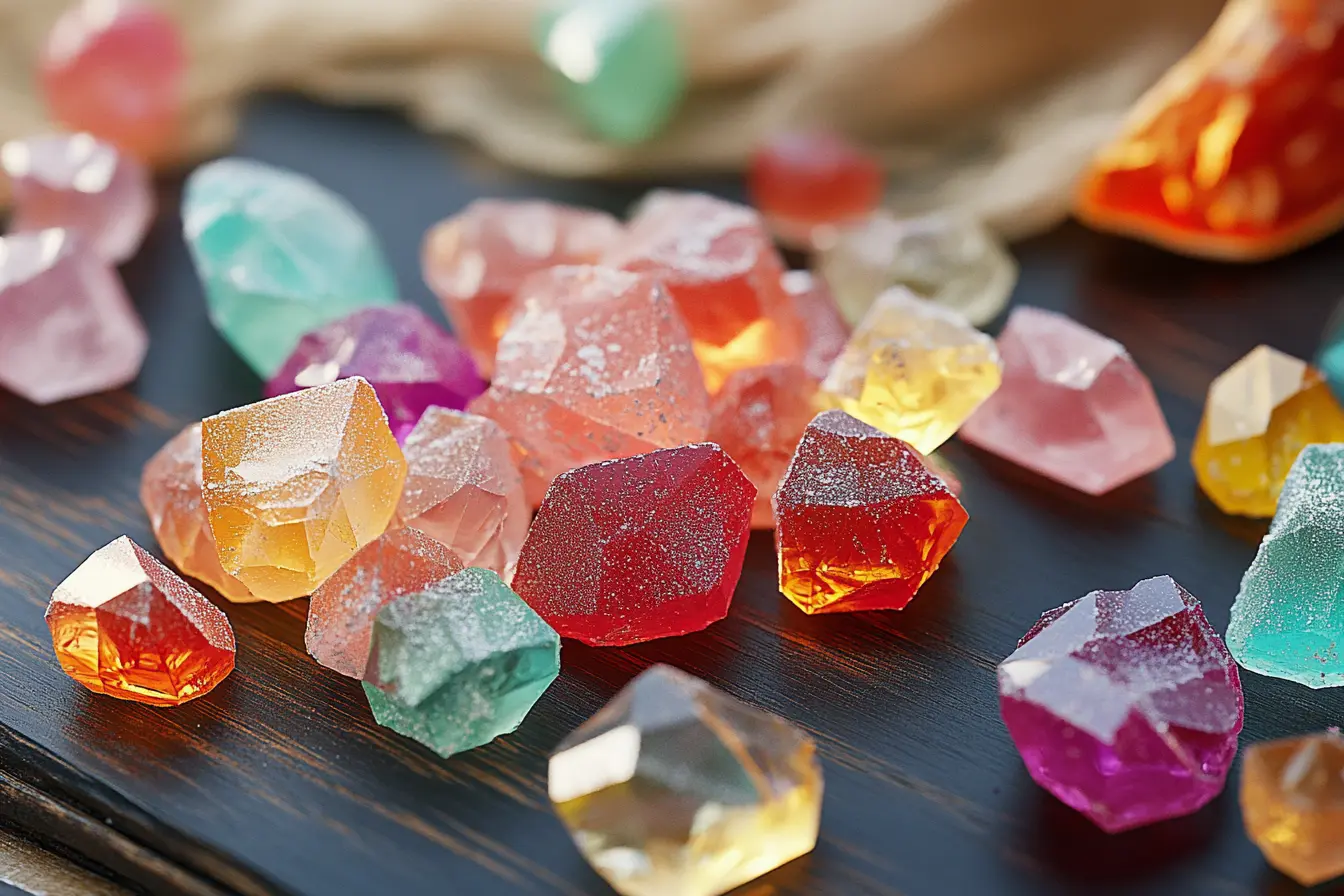What Is Crystal Candy?
Crystal candy, also known as rock candy or sugar crystals, is a mesmerizing treat that combines science and sweetness. To begin with, this sparkling confection is made by growing crystallized sugar from a supersaturated solution. Whether you’re enjoying it as a nostalgic reminder of childhood or crafting it as a fun science experiment, crystal candy has a timeless charm.
What makes it so special? Above all, it’s the glittering, jewel-like appearance that captivates both kids and adults. In fact, it’s more than just a treat—it’s an edible work of art!

The Origins of Rock Candy
Did you know that rock candy dates back centuries? Its roots lie in ancient cultures where sugar was a rare luxury. In places like the Middle East and India, crystallized sugar became an elegant addition to royal celebrations.
As time went on, early cooks and alchemists became intrigued by how sugar solutions formed crystals. This curiosity eventually led to its popularity as a decorative and delicious treat. Today, it remains a sweet tradition in many parts of the world.
Essential Ingredients for Making Sugar Crystals
Creating sugar crystals at home requires just a handful of ingredients:
| Ingredient | Quantity | Notes |
|---|---|---|
| Granulated Sugar | 2 cups | The base for crystallization. |
| Water | 1 cup | Dissolves sugar to create a solution. |
| Food Coloring | A few drops | Adds a pop of color (optional). |
| Flavor Extract | 1 tsp | Gives a unique twist to the taste. |
That’s all you need to transform basic ingredients into sparkling, edible gems!
How to Make Rock Candy at Home
Making rock candy is simpler than it seems. To get started, all you need are a few basic ingredients and a little patience. As a result, you’ll have a delicious and visually stunning treat to enjoy or share.
A Step-by-Step Guide to Homemade Candy Crystals
Making sugar crystals is easier than you might think. Here’s how to do it:
Prepare Your Sugar Solution
- Heat water in a saucepan and slowly stir in the sugar until fully dissolved. As you stir, aim for a supersaturated solution—this is when the water can no longer absorb any more sugar.
Customize with Colors and Flavors
- Add food coloring and flavor extracts of your choice. By doing this, you’ll make your candy not only delicious but also visually stunning.
Start the Crystallization Process
- Pour the solution into a glass jar and place a string or wooden skewer in the center. This setup acts as the foundation for the crystals to grow.
The Waiting Game
- Leave the jar undisturbed in a cool, dry place. Over the next week, watch as sugar crystals form and grow on your skewer.
Enjoy Your Candy Creation
- Carefully remove the skewer, allow it to dry, and marvel at your homemade treat!

The Many Faces of Rock Candy
Rock candy isn’t a one-size-fits-all treat. It comes in various forms to suit different tastes and occasions.
Classic Sugar Crystals
This is the traditional, clear version—pure and unadorned. It’s perfect for those who appreciate simplicity.
Flavored and Colored Variations
From fruity flavors like watermelon to bold ones like espresso, adding colors and extracts lets you experiment endlessly.
The Science of Crystallization
The magic behind sugar crystals lies in the science of crystallization. Let’s explore the basics:
Supersaturation Explained
When water reaches its limit of dissolving sugar, the excess forms crystals as the solution cools.
Key Factors Affecting Crystal Growth
- Temperature: Gradual cooling works best.
- Purity: Use filtered water and refined sugar.
- Stillness: Movement can disrupt crystal formation.
Why Make Candy Crystals at Home?
There are plenty of reasons to try your hand at making this candy:
A Fun Science Experiment
For kids, growing sugar crystals combines science and fun. Plus, it teaches concepts like solutions and crystallization in a hands-on way.
Perfect for Unique Gifts
Sugar crystal sticks make beautiful, personalized gifts. Wrap them with a bow or display them in jars—they’re always a hit!
Troubleshooting Common Issues
Why Didn’t My Crystals Form?
- Possible Reason 1: The solution wasn’t saturated enough.
- Possible Reason 2: High humidity interfered with crystal growth.
How to Fix Cloudy Crystals
Cloudiness often results from impurities in the sugar or water. Use clean ingredients for a clearer finish.
Safe Sugar Handling Tips
Working with boiling sugar requires caution. Here’s how to stay safe:
- Wear oven mitts while handling hot pans.
- Supervise children during the heating process.
- Avoid touching hot syrup, as it can cause burns.
Crystal Candy in Popular Culture
Crystal candy has made its way into pop culture, events, and celebrations worldwide. Beyond being a sweet treat, it has become a symbol of creativity, nostalgia, and charm.
Its Role in Events and Celebrations
From wedding dessert tables to children’s birthday parties, rock candy is often the star of the show. Its sparkling appearance adds a whimsical touch, making it ideal for themed events. Imagine pastel-colored rock candy sticks gracing an Easter party or bold red ones at a holiday event—pure magic!
This candy is also a staple in many cultural festivals, especially in countries where sweets are central to celebrations. In some Asian traditions, for instance, rock candy is associated with good luck and prosperity, making it a popular gift during Lunar New Year.
Appearances in Media and Art
Crystal candy has found its way into films, TV shows, and even social media trends. Who can forget the iconic scenes in popular TV series where candy-making played a pivotal role? Additionally, social media influencers have embraced crystal candy for DIY tutorials, ASMR videos, and even decorative purposes. It’s not just a treat—it’s a visual and auditory delight.
How to Store and Preserve Crystal Candy
Crystal candy’s charm extends far beyond your kitchen. For instance, it’s deeply rooted in cultures around the world, each putting its unique spin on this sparkling treat.
Best Containers and Conditions
- Store crystal candy in airtight containers to prevent moisture absorption. Glass jars or plastic containers with tight seals work best.
- Keep the container in a cool, dry place, away from sunlight. Excess heat can cause the crystals to melt or lose their structure.
Avoiding Moisture and Staleness
Humidity is the enemy of crystal candy. Even a small amount of moisture can ruin its texture. If you live in a humid area, consider adding a small silica gel packet to the storage container to keep it dry.
Creative Uses for Crystal Candy
Crystal candy isn’t just for eating—it’s also a versatile decoration and gift.
Cake Decorations and Toppers
Crystal candy makes an excellent addition to cakes and cupcakes. Its glittering appearance resembles edible jewels, giving baked goods a touch of elegance. For weddings or anniversaries, a cake adorned with crystal candy is sure to impress guests.
Centerpieces and Party Favors
Use crystal candy as part of a table centerpiece for events. Place them in decorative jars or vases, and you’ve got an eye-catching display. Alternatively, wrap individual candy sticks in cellophane and tie them with a ribbon for party favors.
Where Can You Find Rock Candy?
Not everyone has the time to make crystal candy from scratch, and that’s okay! There are plenty of places to find high-quality options.
Online Stores and Marketplaces
E-commerce platforms like Amazon, Etsy, and specialty candy shops often sell a wide variety of crystal candy. Whether you’re looking for bulk orders or custom designs, the internet has you covered.
Local Artisanal Shops
Support local businesses by checking out artisanal candy stores. Many of these shops offer handmade rock candy with unique flavors and vibrant colors. Plus, you can often sample before you buy!
Environmental Impact of Crystal Candy Packaging
As with any product, it’s essential to consider the environmental footprint of crystal candy. Fortunately, there are ways to enjoy this treat sustainably.
Eco-Friendly Alternatives
Many brands are now opting for biodegradable or recyclable packaging. If you’re making crystal candy at home, use glass jars or paper wrappers instead of plastic.
Recycling and Sustainability Tips
Dispose of packaging responsibly by recycling where possible. You can even repurpose glass jars used for storing candy as decorative items or storage containers for other treats.
Crystal Candy: A Treat for All Ages
Crystal candy is one of those rare treats that can bring joy to people of all ages.
A Nostalgic Dessert for Adults
For adults, crystal candy often evokes fond memories of childhood—visiting candy shops, enjoying colorful sticks on summer days, or receiving them as holiday gifts. It’s a nostalgic dessert that takes us back to simpler times.
A Fascinating Experiment for Kids
For kids, crystal candy is more than a snack—it’s an adventure. Watching sugar crystals grow day by day is like witnessing magic in real life. The experience of making and eating crystal candy teaches patience, curiosity, and a bit of kitchen science.
How Crystal Candy Inspires Creativity
Crystal candy isn’t just a sweet indulgence; it’s a creative outlet for those who love experimenting in the kitchen. By combining different flavors, colors, and techniques, you can create unique designs that showcase your personality.
Imagine making a rainbow rock candy stick with multiple layers of colors. It’s not only a treat for the taste buds but also a feast for the eyes. Whether you’re crafting for a special occasion or simply for fun, rock candy provides endless opportunities to unleash your creativity.
The Global Appeal of Crystal Candy
Rock candy’s charm extends far beyond your kitchen. For instance, it’s deeply rooted in cultures around the world, each putting its unique spin on this sparkling treat.
Cultural Variations of Crystal Candy
- In China, rock sugar is used in traditional cooking and even herbal medicine. Furthermore, it is believed to have health benefits when used in moderation.
- In India, a form of crystal candy known as “mishri” is a common sweetener in desserts and religious offerings.
- Meanwhile, in Western countries, brightly colored rock candy sticks are carnival staples, often associated with fun and festivities.

Conclusion
Crystal candy is much more than a sugary treat. In fact, it’s an art form, a science experiment, and a cherished tradition all rolled into one. Whether you’re crafting it at home, giving it as a gift, or simply enjoying its beauty, rock candy brings sweetness and wonder to life.
So, what are you waiting for? By following these tips and tricks, you’ll soon discover why rock candy has been loved for generations. Whether it’s the fun of making it, the joy of eating it, or the delight in sharing it, there’s no denying the magic of this sparkling masterpiece.
FAQs
What is the best sugar to use for crystal candy?
Granulated white sugar works best for making crystal candy, as it dissolves easily and forms clear crystals.
How long does it take to grow crystal candy?
The process usually takes 5-7 days, depending on conditions like temperature and humidity.
Is crystal candy halal?
Yes, crystal candy is halal as it typically contains only sugar, water, and optional flavoring or coloring. Be sure to check flavor extracts and food colorings for halal certification if needed.
What is crystal candy made of?
Crystal candy is made of granulated sugar, water, and sometimes food coloring or flavor extracts. These ingredients are crystallized to form the candy.
Is crystal candy the same as rock sugar?
Not exactly. While both are made from crystallized sugar, rock sugar is usually larger and less refined, often used in cooking or tea. Crystal candy is more decorative and often enjoyed as a treat.
Does crystal candy taste good?
Yes! Crystal candy has a pure, sweet taste. You can enhance its flavor by adding extracts like vanilla, mint, or fruit flavors during preparation.
